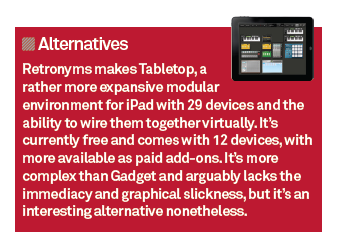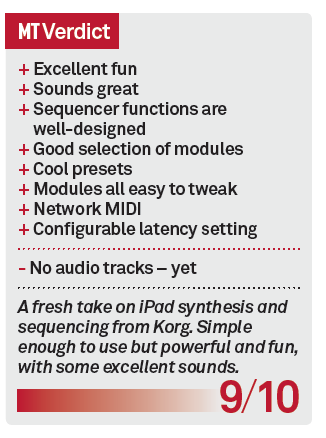Korg Gadget IOS Review
iPad music production just got even cooler with the release of Korg’s Gadget suite. Hollin Jones dives in. Details Price £26.99 Contact Korg – 01908 304601 Web www.korg.co.uk Minimum system requirements – iPad 2 or higher -iOS 7 Korg was one of the first developers to build a synth and sequencing package for the iPad platform with […]

iPad music production just got even cooler with the release of Korg’s Gadget suite. Hollin Jones dives in.


Details
Price £26.99
Contact Korg – 01908 304601
Web www.korg.co.uk
Minimum system requirements – iPad 2 or higher -iOS 7
Korg was one of the first developers to build a synth and sequencing package for the iPad platform with iElectribe way back in 2010. Since then it has made other notable iOS apps such as iPolysix and iMS20, re-creations of its own classic hardware. Gadget is something quite different, combining 15 synthesizers and drum machines with a touch MIDI sequencer to provide an electronic programming and sound-design environment. Crucially, these aren’t re-creations as such, but new, specially designed modules.
Gadget runs on an iPad 2 or higher (including iPad Mini), though the number of modules you can run is limited on older hardware. Older models will manage five tracks, or eight if you use the freeze function. Third- and fourth-generation iPads will manage 8/12 and 15/20 tracks respectively, and the newest iPad Air and Mini Retina models up to 25/35 tracks thanks to their advanced A7 processor.
Visually, the app is an interesting mix of minimal and ornate. The body of the app is stripped-down and futuristic, making the function of the various controls very clear. The gadgets themselves look really cool, and while this obviously doesn’t affect their sound, it’s definitely a plus point if only because people looking over your shoulder will be impressed when you use it in public.

Up and Running
The app works in portrait mode and in the upper part is the sequencer area, with the lower section housing the mixer and instrument interfaces when required. You start by loading a gadget and choosing from a grid of the 15 available types. Selecting one takes you to a grid sequencer and a tweakable interface for the instrument.
You can enter notes in several ways. The first is to tap in the grid and drag to set note length. Pressing the Function button here enables you to set the bar length, play mode and grid setting for this pattern, so it’s easy to create anything from half to 1/64 repeats or even turn the grid off to play freeform. You can also play notes using the keys attached to a synth and there’s CoreMIDI support for connected devices. Network MIDI is available, too.
As well as the Draw command in a sequencer grid you can select multiple notes and alter their velocity or pitch en masse. Tap in the automation area to reveal all automatable parameters for an instrument. There can be quite a few of these and you draw in data by painting it with your finger.
The pattern sequencer is one of the most user-friendly around, and makes light work of programming. Tap back into the main screen and you can add multiple scenes to build up a track. The sequencer is clever enough to allow one scene to play out before starting another, so you’ll never slip out of time.
Go go Gadgets
The gadgets themselves are named after cities, each one loosely suggestive of a kind of electronic music associated with the sounds it makes (you can hear previews on Korg’s website). On the whole they sound excellent, and each one naturally has its own presets. The modules can all be tweaked, too, with dials, knobs and sliders letting you create and morph your own sounds and save patches.

There are some great sounds on offer, perfect for all kinds of electronic music. You could even incorporate them into your computer-based setup with a little creative routing. You don’t have to be a synth expert, either – just play around and you’ll be guaranteed some nice, fat sounds. Some have onboard effects and there’s support for effect sends and a limiter and reverb on the master buss.

Gadget supports both AudioCopy and WIST, a protocol for linking compatible apps and devices via BlueTooth. You can also export tracks to an audio file, to Dropbox and upload them to Korg’s own GadgetCloud, a collaboration and gallery system for showcasing your music. There’s Audiobus support, too, so with that app installed you can incorporate Gadget into a more complex instrument and effect chain within the iOS environment. Interestingly, Korg also details its roadmap for Gadget, stating that new gadgets will be introduced in the future and there will even be audio track support, which will greatly enhance its potential as a more all-round music production system.
Pick me Up
Gadget is tremendous fun to use, easy to get to grips with and surprisingly flexible. It sounds excellent, and although it’s fairly heavily geared towards electronic music, the clever design and flexibility of the modules means it can be a sound-design tool as well. You can pick it up and be making banging tracks in just a few minutes, but there’s a depth of programming and editing features as well.
For this many well-designed and cool-sounding synths the price is certainly fair, and it’s nice to see a whole new set of instruments from Korg, especially one wrapped up in such a well-designed app


